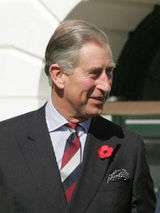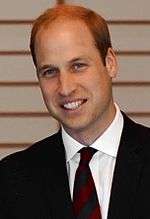Wikijunior:Kings and Queens of England/Future monarchs
< Wikijunior:Kings and Queens of EnglandCharles, Prince of Wales

Prince Charles, who was born at Buckingham Palace on 14 November 1948, is the eldest son of Elizabeth II and Prince Philip, Duke of Edinburgh. He is the heir to the throne of the United Kingdom. The Prince of Wales is well known for his extensive charity work, particularly for the Prince's Trust. He also carries out a full schedule of royal duties, and increasingly is taking on more royal roles from his aging mother. The Prince is also well known for his high profile marriages to the late Lady Diana Spencer and subsequently to Camilla, The Duchess of Cornwall.
Early life
In 1952, his mother assumed the throne, becoming Queen Elizabeth II. Prince Charles immediately became Duke of Cornwall. He also became the Duke of Rothesay, the title by which he is known in Scotland.
He went to Hill House School in West London, and later the Cheam preparatory school in Berkshire, which the Duke of Edinburgh also went to. The Prince finished his education at Gordonstoun, a private boarding school in the north east of Scotland. His father, the Duke of Edinburgh, had previously attended Gordonstoun, becoming head boy. It is often reported that the Prince hated his time at the school, where he was a frequent target for bullies. In 1966 Charles spent two terms at Geelong Grammar School in Victoria, Australia during which time he also visited Papua New Guinea. On his return to Gordonstoun he followed in his father's footsteps by becoming head boy. In 1967 he left Gordonstoun with two A levels, in history and French.
Traditionally, the heir to the throne would go straight into the military after finishing school. However, Charles went to university at Trinity College, Cambridge where he studied Anthropology and Archaeology, and later History, earning a 2:2 (a lower second class degree). Charles was the first member of the British Royal Family to be awarded a degree. He also went to the University College of Wales, Aberystwyth to learn the Welsh language, making him the first English-born Prince of Wales ever to make a serious attempt to do so.
He was created The Prince of Wales and Earl of Chester in 1958, though his actual investiture did not take place until 1 July 1969. This was a major ceremony, held at Caernarfon Castle in north Wales, a place traditionally associated with the creation of the title in the 13th century. The Welsh borough of Swansea was granted city status to mark the occasion. He served on HMS Norfolk as Sub Luietenant Prince of Wales in the early seventies.
First marriage
On 29 July 1981, The Prince of Wales married Lady Diana Spencer at St Paul's Cathedral before 3,500 invited guests and an estimated 750 million people around the world. Almost immediately, the Princess of Wales became a star attraction, chased by the press, her every move (including every change in hairstyle) closely followed by millions. However, the marriage soon became troubled. Within five years of the wedding the marriage was already on the brink of collapse, and though they remained publicly a couple, they had effectively separated by the mid 1990s, he living in Highgrove, she in Kensington Palace. They divorced on 28 August 1996. They had had two sons, Prince William of Wales and Prince Henry of Wales, who is known by the name "Harry". Diana, Princess of Wales was killed in a car accident in Paris, France in 1997.
Second marriage
After his divorce from Diana, Princess of Wales, The Prince of Wales's relationship with Camilla Parker Bowles eventually became openly acknowledged, with her becoming his unofficial consort. Over time, opinion shifted to a point where a civil marriage would be acceptable. They married on 9 April 2005. It was announced that, after the marriage, as the wife of The Prince of Wales, Camilla would be styled Her Royal Highness The Duchess of Cornwall and that upon the Prince's accession to the throne, she would not be known as Queen Camilla but as Her Royal Highness The Princess Consort.
Personal interests
The Prince of Wales is a keen horseman and huntsman. He served in the Royal Navy from 1971 to 1976, commanding HMS Bronington, a minehunter, from February 1976 until December 1976. He is also a watercolour artist and a published writer. He has exhibited and sold a number of paintings. The Prince's Trust, which he founded, is a charity that works mainly with young people, offering loans to groups, businesses and people (often in deprived areas) who had difficulty receiving outside support. Fundraising concerts are regularly held for the Prince's Trust, with leading pop, rock and classical musicians taking part
To put his ideas on architecture and town planning into practice, the Prince of Wales is developing the village of Poundbury in Dorset. Prior to commencing work on Poundbury he had published a book and produced a documentary called A Vision for Britain. In 1992 he also established The Prince of Wales Institute of Architecture and began the publication of a magazine dealing with architecture, but the latter has since ceased independent operation after being merged with another charity to create The Prince's Foundation for the Built Environment in 2001. The Prince is also keen on growing and promoting organic food, although he drew some ridicule when he joked about sometimes talking to his houseplants. The Prince of Wales is President of 16 charities, and raised over £100 million for charity in 2004.
Prince William of Wales

Prince William of Wales was born at St. Mary's Hospital, Paddington on 21 June 1982. His parents are Charles, Prince of Wales and Lady Diana Spencer. He is second in the line of succession to the British throne.
On 1 March 1991 (St. David's Day), Prince William made his first official public appearance during a visit to Cardiff, the capital city of Wales. After arriving by plane, the eight-year-old prince was taken by his parents to Llandaff Cathedral. After a tour of the cathedral, he signed its visitors book, which showed that he was left-handed. Prince William went to the Mrs Jane Mynors' nursery school and the pre-prep Wetherby School both in West London, and later attended Ludgrove School in Berkshire. After passing an entrance exam he went on to attend Eton College in Berkshire. Whilst there he studied geography, biology and history of art at A-level.
Like a growing number of British teenagers, Prince William chose to take a gap year after finishing Eton College. He took part in British Army training in Belize. He spent the final stage of his gap year in southern Chile as a volunteer with Raleigh International. Pictures of the prince cleaning a toilet were broadcast around the world. After his gap year, Prince William attended the University of St Andrews in Fife, Scotland from 2001 until he was graduated in 2005. He started doing a degree course in Arts History, although he later changed his main subject to Geography and gained a Scottish Master of Arts degree with upper-second class honours. In January 2006, the prince began his cadet course at the Royal Military Academy Sandhurst to train as an Army Officer. William joined his brother who had been there since May 2005.
In July 2005, William carried out his first official engagements representing Elizabeth II, as Queen of New Zealand, at World War II commemorations in New Zealand. In September of the same year, it was announced that William will become president of The Football Association in May 2006 and patron to the UK charity Centrepoint, which works with homeless young people. In April 2011, he married Kate Middleton. In July 2013, the Duchess of Cambridge gave birth to their son, Prince George of Cambridge, third in line to the throne. The couple's second child, their daughter Princess Charlotte of Cambridge who is fourth in line to the throne, was born in May 2015.